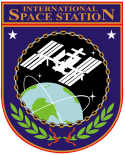STS-92
 | |
| Dane misji | |
| Indeks COSPAR | 2000-062A |
|---|---|
| Zaangażowani | |
| Oznaczenie kodowe | STS-92 |
| Pojazd | |
| Wahadłowiec | Discovery |
| Załoga | |
 Od lewej: Leroy Chiao, Pamela Melroy, Michael Lopez-Alegria, William McArthur, Peter Wisoff, Brian Duffy i Koichi Wakata | |
| Dowódca | Brian Duffy |
| Start | |
| Miejsce startu | Stany Zjednoczone, KSC, LC39-A |
| Początek misji | 11 października 2000 23:17:00 UTC |
| Orbita okołoziemska | |
| Apogeum | 394 km |
| Perygeum | 386 km |
| Okres orbitalny | 92,28 min |
| Inklinacja orbity | 51,6° |
| Lądowanie | |
| Miejsce lądowania | Edwards Air Force Base, Kalifornia, pas startowy 22 |
| Lądowanie | 24 października 2000 20:59:41 UTC |
| Czas trwania misji | 12 dni, 21 godzin, 42 minuty i 41 sekund |
| Przebyta odległość | ponad 8,5 mln km |
| Liczba okrążeń Ziemi | 203 |
| Program lotów wahadłowców | |
STS-92 (Space Transportation System) – misja wahadłowca Discovery do Międzynarodowej Stacji Kosmicznej. Był to dwudziesty ósmy lot Discovery, a jednocześnie setny, jubileuszowy lot amerykańskiego wahadłowca w ramach programu lotu wahadłowców[1].
Załoga
- źródło[1]
- Brian Duffy (4)*, dowódca
- Pamela A. Melroy (1), pilot
- Koichi Wakata (2), specjalista misji 4 (Japonia)
- Leroy Chiao (3), specjalista misji 1
- Peter „Jeff” K. Wisoff (4), specjalista misji 3
- Michael E. Lopez-Alegria (2), specjalista misji 5
- William S. McArthur (3), specjalista misji 2
- *(liczba w nawiasie oznacza liczbę lotów odbytych przez każdego z astronautów)
Parametry misji
- Masa:
- startowa orbitera: 115 127 kg
- lądującego orbitera: 92 741 kg
- ładunku: 9513 kg
- Perygeum: 386 km
- Apogeum: 394 km
- Inklinacja: 51,6°
- Okres orbitalny: 92,28 min
Cel misji
Piąty lot promu kosmicznego na stację kosmiczną ISS – dostarczenie segmentu Z1 kratownicy ITS (Integrated Truss Structure)[1].
Dokowanie do ISS
- Połączenie z ISS: 13 października 2000, 17:45:10 UTC
- Odłączenie od ISS: 20 października 2000, 15:08:39 UTC
- Łączny czas dokowania: 6 dni, 21 h, 23 min, 29 s
Ładunek
- Integrated Truss Structure Z1 – ważąca 8,5 tony aluminiowa struktura kratownicowa, będąca bazą dla zestawu paneli baterii słonecznych, zawierająca cztery żyroskopy CMG (Control Moment Gyro), część aparatury komunikacyjnej w paśmie S i Ku, podsystem zasilania elektrycznego, sprzęt dla astronautów pracujących na zewnątrz stacji oraz system kontroli termicznej,
- Pressurized Mating Adapter 3 – trzeci adapter hermetyczny dla modułu Unity, obecnie zamontowany do modułu Tranquility.
Spacer kosmiczny
- źródło[1]
- EVA-1 (15 października 2000, 6 godz. 28 min): L. Chiao, W. McArthur.
- EVA-2 (16 października 2000, 7 godz. 7 min): P. Wisoff, M. Lopez-Alegria.
- EVA-3 (17 października 2000, 6 godz. 48 min): L. Chiao, W. McArthur.
- EVA-4 (18 października 2000, 6 godz. 56 min): P. Wisoff, M. Lopez-Alegria.
Zobacz też
Przypisy
Bibliografia
- Podsumowanie misji na stronie KSC (ang.)
- NSSDCA Master Catalog (ang.)
- Mark Wade: STS-92 (ang.). W: Encyclopedia Astronautica [on-line]. [dostęp 2017-07-27].
Linki zewnętrzne
- Spaceflight mission report: STS-92 (ang.). Spacefacts. [dostęp 2017-07-27].
Media użyte na tej stronie
The flag of Navassa Island is simply the United States flag. It does not have a "local" flag or "unofficial" flag; it is an uninhabited island. The version with a profile view was based on Flags of the World and as a fictional design has no status warranting a place on any Wiki. It was made up by a random person with no connection to the island, it has never flown on the island, and it has never received any sort of recognition or validation by any authority. The person quoted on that page has no authority to bestow a flag, "unofficial" or otherwise, on the island.
STS-92 crew: Seated in the front Pamela A. Melroy and Brian Duffy (Commander). In the rear from left to right: Leroy Chiao, Michael E. Lopez-Alegria, William S. McArthur, Peter J.K. „Jeff“ Wisoff and Koichi Wakata.
Designed by the crew members, the STS-92 patch symbolizes the second mission to carry U.S.-built elements to the International Space Station (ISS) for assembly. The black silhouette of the Space Shuttle Discovery stands out against the deep blue background of space in low Earth orbit. In the foreground in gray is a profile view of the ISS as it appears when the shuttle and crew arrive, with the station consisting of the Unity node, its two pressurized mating adapters (PMA), the Zarya functional cargo block, the Zvezda service module, and the Progress cargo vehicle.
Following the shuttle's rendezvous and docking, the ISS configuration will be augmented by the two elements delivered by Discovery–the Z1 truss and PMA-3. These two elements, depicted in red, will be installed using the shuttle's robot arm and be connected to ISS during four spacewalks. The multi-national nature of both the STS-92 crew and the ISS are reflected in the multi-colored Astronaut Office symbol.




